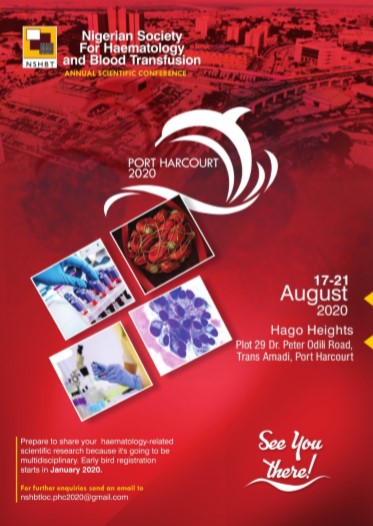Editorial Comment
Dear Colleagues and Readers of the Nigerian Journal of Haematology, It is my great pleasure and privilege to write this editorial comment. This issue of the Nigerian Journal of Haematology presents the Guidelines for Management of Venous Thromboembolism in Nigeria, the results of a tremendous amount of work by dedicated Nigerian haematologists: Profs Shokunbi WA; Akanmu A Sulaimon; Ogbe O Patrick; Awodu OA; Bolarinwa Rahman; Yuguda Saleh; Omunakwe H; and Okoye Helen C.
privilege to write this editorial comment. This issue of the Nigerian Journal of Haematology presents the Guidelines for Management of Venous Thromboembolism in Nigeria, the results of a tremendous amount of work by dedicated Nigerian haematologists: Profs Shokunbi WA; Akanmu A Sulaimon; Ogbe O Patrick; Awodu OA; Bolarinwa Rahman; Yuguda Saleh; Omunakwe H; and Okoye Helen C.
In 2016, the NSHBT dedicated the annual meeting of the Society to thrombosis and haemostasis. This became possible by the engagement of Nigerian colleagues in the International Society on Thrombosis and Hemostasis (ISTH), and the Council of NSHBT who organized an excellent joint Workshop/Congress of NSHBT and ISTH. Translating new information into clinical practice is often very difficult. This is especially true for haematology and haemostasis as often patients with bleeding or thrombotic disorders are treated by colleagues in other specialities due to comorbidities. The role of the haematologist is to transfer the most recent knowledge and information in haemostasis into clinical practice, also of other specialities. The guidelines presented in this issue will be instrumental in achieving this goal, especially as they have taken into consideration the resources available for Nigerian physicians and patients.
For those in training and especially for non-haematologists, guidelines are an invaluable source of practice improvement. It will be an important task for NHSBT to organize regular structured updates of these guidelines in the coming years to secure that they continue to reflect the current standard of medical practice.
Guidelines are also an excellent starting point for asking new research questions, especially in areas in which the guidelines do not provide sufficient information, e.g. for management of sickle cell anemia patients. With the evolving understanding that sickle cell anemia is associated with a chronic prothrombotic state, the question of prophylactic anticoagulation to preventing organ damage might be a very relevant issue to answer. Nigerian haematologists are in the position to perform such studies and to contribute hereby to international guideline development.
The educational committee of the ISTH has followed with great interest the work of the NSHBT guidelines committee. Based on the current achievements, the ISTH Educational Committee is looking forward to receiving a new proposal for a second educational workshop on thrombosis and haemostasis in Nigeria.
Beside the guidelines, this issue of the Journal presents a study on lead poisoning in children. Doppler investigation of intrarenal arterial resistance to detect early renal impairment in patients with sickle cell disease; and the pattern of anaemia in male patients with leprosy; are further interesting contributions in addition to an excellent review article on advances in the management of haemophilia by a good friend of mine.
Congratulations to the Editors of the Journal and the Council of NSHBT for they have further established their journal as a source of knowledge transfer and medical education in Nigeria, which will gain attention far beyond haematology.
Prof. Andreas Greinacher,
Greifswald, Germany,
August 13, 2018








